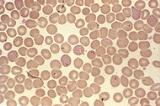
Piroplasmida
Encyclopedia
Piroplasms are protozoan parasite of the phylum
Apicomplexa
. They divide by binary fission and as sporozoan parasites they possess sex
ual and asexual
phases (sexual reproduction occurs in the tick gut). They include the tick
parasites Babesia
and Theileria
.
There is an apical complex with polar ring and rhopteries but without a conoid and usually without associated pellicular microtubules. They lack flagella and do not form either oocysts or spores.
The known vectors are tick
s or leeches in which they undergo sporogony;
Sexual reproduction probably occurs in the vector.
Phylum
In biology, a phylum The term was coined by Georges Cuvier from Greek φῦλον phylon, "race, stock," related to φυλή phyle, "tribe, clan." is a taxonomic rank below kingdom and above class. "Phylum" is equivalent to the botanical term division....
Apicomplexa
Apicomplexa
The Apicomplexa are a large group of protists, most of which possess a unique organelle called apicoplast and an apical complex structure involved in penetrating a host's cell. They are unicellular, spore-forming, and exclusively parasites of animals. Motile structures such as flagella or...
. They divide by binary fission and as sporozoan parasites they possess sex
Sex
In biology, sex is a process of combining and mixing genetic traits, often resulting in the specialization of organisms into a male or female variety . Sexual reproduction involves combining specialized cells to form offspring that inherit traits from both parents...
ual and asexual
Asexual reproduction
Asexual reproduction is a mode of reproduction by which offspring arise from a single parent, and inherit the genes of that parent only, it is reproduction which does not involve meiosis, ploidy reduction, or fertilization. A more stringent definition is agamogenesis which is reproduction without...
phases (sexual reproduction occurs in the tick gut). They include the tick
Tick
Ticks are small arachnids in the order Ixodida, along with mites, constitute the subclass Acarina. Ticks are ectoparasites , living by hematophagy on the blood of mammals, birds, and sometimes reptiles and amphibians...
parasites Babesia
Babesia
Babesia is a protozoan parasite of the blood that causes a hemolytic disease known as Babesiosis. There are over 100 species of Babesia identified; however only a handful have been documented as pathogenic in humans....
and Theileria
Theileria
Theileria is a genus of parasitic protozoan that belongs to the phylum Apicomplexa and is closely related to Plasmodium. Two Theileria species, T. annulata and T. parva, are important cattle parasites. T. annulata causes tropical theileriosis and T. parva causes East Coast fever. Theileria are...
.
Description
Minute rounded or pyriform parasites found within erythrocytes, or other circulating or endothelial cells of vertebrates, where they reproduce by merogony. The trophozoite stage separated from erythrocyte by single membrane This distinguishes them from other blood parasites that usually have at least 2 membranes.There is an apical complex with polar ring and rhopteries but without a conoid and usually without associated pellicular microtubules. They lack flagella and do not form either oocysts or spores.
The known vectors are tick
Tick
Ticks are small arachnids in the order Ixodida, along with mites, constitute the subclass Acarina. Ticks are ectoparasites , living by hematophagy on the blood of mammals, birds, and sometimes reptiles and amphibians...
s or leeches in which they undergo sporogony;
Sexual reproduction probably occurs in the vector.

